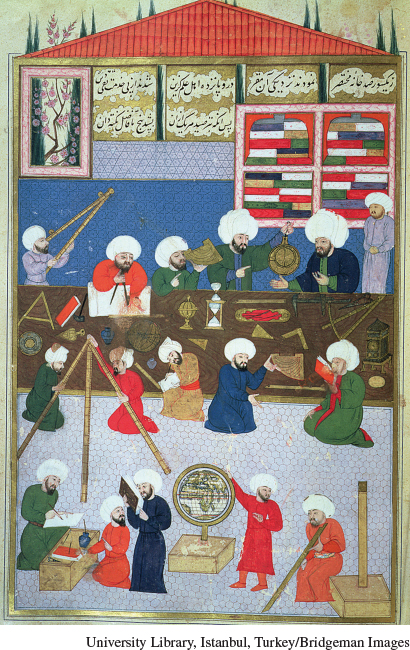Networks of Exchange
AP® EXAM TIP
You are expected to know the features, participants, and extent of the Muslim trade networks.
The world of Islamic civilization cohered not only as a network of faith but also as an immense arena of exchange in which goods, technologies, food products, and ideas circulated widely. Now large areas of the Afro-
Guided Reading Question
▪CONNECTION
In what ways was the world of Islam a “cosmopolitan civilization”?
AP® EXAM TIP
These examinations of the “Islamic Green (agricultural) Revolution” and the accompanying spread of technology and science across the Muslim world are very important.
Thus Muslim merchants, Arabs and Persians in particular, quickly became prominent and sometimes dominant players in all the major Afro-

The vast expanse of Islamic civilization also contributed to ecological change as agricultural products and practices spread from one region to another, a process already under way in the earlier Roman and Persian empires. Among the food crops that circulated within and beyond the Islamic world were different varieties of sugarcane, rice, apricots, artichokes, eggplants, lemons, oranges, almonds, figs, and bananas. Equally significant were water-management practices, so important to the arid or semi-arid environments of many parts of the Islamic world. Persian-style reservoirs and irrigation technologies spread as far as Tunisia and Morocco, the northern fringes of the Sahara, Spain, and Yemen. By connecting different environmental zones, particularly those where water availability was the major obstacle to agricultural growth, particular regions could draw upon a wide range of crops and practices. All of this contributed to an “Islamic Green Revolution” of increased food production as well as to population growth, urbanization, and industrial development across the Islamic world.
Technology too diffused widely within the realm of Islam. Muslim technicians made improvements on rockets, first developed in China, by developing one that carried a small warhead and another used to attack ships. Papermaking techniques entered the Abbasid Empire from China in the eighth century or earlier, with paper mills soon operating in Persia, Iraq, and Egypt. This revolutionary technology, which everywhere served to strengthen bureaucratic governments, passed from the Middle East into India and Europe over the following centuries. Everywhere it spurred the emergence of books and written culture at the expense of earlier orally based cultural expressions.
Ideas likewise circulated across the Islamic world. The religion itself drew heavily and quite openly on Jewish and Christian precedents. Persia also contributed much in the way of bureaucratic practice, court ritual, and poetry, with Persian becoming a major literary language in elite circles. Scientific, medical, and philosophical texts, especially from ancient Greece, the Hellenistic world, and India, were systematically translated into Arabic, providing an enormous boost to Islamic scholarship and science for several centuries. In 830, the Abbasid caliph al-Mamun, himself a poet and scholar with a passion for foreign learning, established the House of Wisdom in Baghdad as an academic center for this research and translation. Stimulated by Greek texts, a school of Islamic thinkers known as Mutazalites (“those who stand apart”) argued that reason, rather than revelation, was the “surest way to truth.”30 In the long run, however, the philosophers’ emphasis on logic, rationality, and the laws of nature was subject to increasing criticism by those who held that only the Quran, the sayings of the Prophet, or mystical experience represented a genuine path to God.
SNAPSHOTKey Achievements in Islamic Science and Scholarship
| Person/Dates | Achievement |
| al-Khwarazim (790–840) | Mathematician; spread use of Arabic numerals in Islamic world; wrote first book on algebra |
| al-Razi (865–925) | Discovered sulfuric acid; wrote a vast encyclopedia of medicine drawing on Greek, Syrian, Indian, and Persian work and his own clinical observation |
| al-Biruni (973–1048) | Mathematician, astronomer, cartographer; calculated the radius of the earth with great accuracy; worked out numerous mathematical innovations; developed a technique for displaying a hemisphere on a plane |
| Ibn Sina (Avicenna) (980–1037) | Prolific writer in almost all fields of science and philosophy; especially known for Canon of Medicine, a fourteen-volume work that set standards for medical practice in Islamic and Christian worlds for centuries |
| Omar Khayyam (1048–1131) | Mathematician; critic of Euclid’s geometry; measured the solar year with great accuracy; Sufi poet; author of The Rubaiyat |
| Ibn Rushd (Averroës) (1126–1198) | Translated and commented widely on Aristotle; rationalist philosopher; made major contributions in law, mathematics, and medicine |
| Nasir al-Din Tusi (1201–1274) | Founder of the famous Maragha observatory in Persia (data from Maragha probably influenced Copernicus); mapped the motion of stars and planets |
| Ibn Khaldun (1332–1406) | Greatest Arab historian; identified trends and structures in world history over long periods of time |
But the realm of Islam was much more than a museum of ancient achievements from the civilizations that it encompassed. Those traditions mixed and blended to generate a distinctive Islamic civilization with many new contributions to the world of learning. (See Snapshot, above.) Using Indian numerical notation, for example, Arab scholars developed algebra as a novel mathematical discipline. They also undertook much original work in astronomy and optics. They built on earlier Greek and Indian practice to create a remarkable tradition in medicine and pharmacology. Arab physicians such as al-